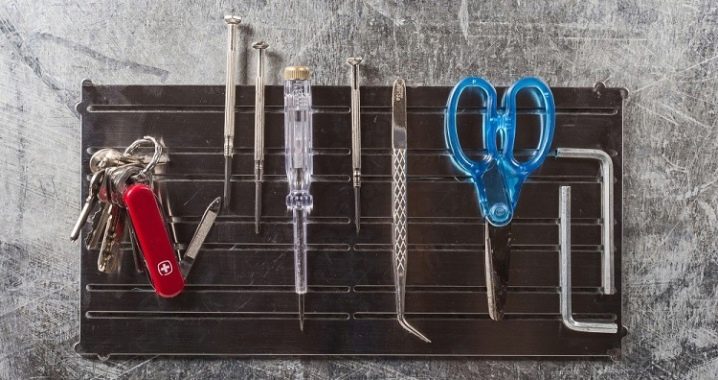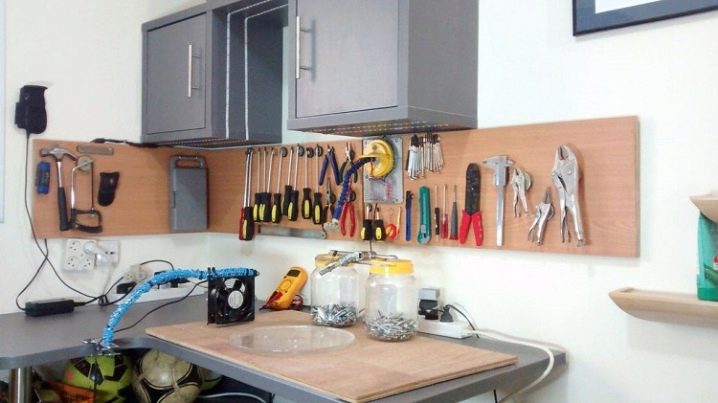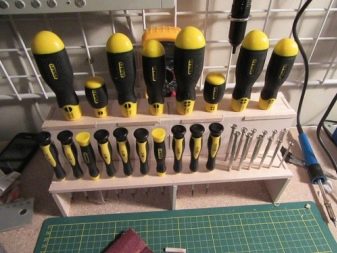Tool holders: types and tips for choosing

The safety of instruments and the convenience of their operational use largely depend on the conditions of their storage. Therefore, it is worth considering the existing types of tool holders and familiarizing yourself with advice on their selection and modernization.

Peculiarities
Basic requirements for to modern storage systems for tools:
- structural reliability;
- durability and safety of the materials used;
- ease of attachment and removal of the tool;
- the convenience of use;
- compactness and ergonomics;
- the possibility of modernization when expanding the set of stored products;
- profitability;
- transportability in case of moving;
- presentable appearance;
- ease of cleaning.

Varieties
Currently, such main types of holders:
- wall panels with hooks and holders;
- magnetic fastening systems;
- cabinets, racks and layouts;
- floor stands;
- desktop boxes and stands;
- mobile stands;
- folding tables.



Selection Tips
If you want to save time and get a quality product, you can purchase a ready-made structure. Such products are produced, for example, by the Element System company. For most DIYers, the versatile perforated wall panels are suitable for attaching trays, holders and hooks. The most popular models of such panels are Nr-1 and Nr-2. Both options are supplied in a standard size of 800 × 400 mm, while the second model is equipped with an extended set of plastic containers for storing fasteners.
Other popular manufacturers of similar products are Stark, Intertool, TOPEX and Virokoffering a wide range of plastic and metal wall panels in various sizes, from compact 350 × 390 mm to voluminous 800 × 400 mm.


If you are interested in magnetic holders, then a wide range of such products in various sizes offers company "Asko-Ukrem"... In the catalog of its products, you can find both the simplest designs in the form of a magnetic strip with fastening elements, and complex systems that combine a magnetic strip with separate magnets, drawers and shelves.
Other well-known manufacturers of magnetic storage systems are Geko, Kenovo and Force. Their range is mainly represented by magnetic steel strips of various sizes for workbenches or wall mounting.
The main parameter that must be taken into account when choosing a specific model of the holder is the size of the free space on which it will be installed. Ideally, you should measure in advance the area where you plan to place the structure and record the measurement results.



You should also consider the distance between the individual fasteners - the tool should be freely removed from the hooks and brackets without interference.
Self-production
For an experienced craftsman, it will not be difficult to create a convenient holder for your tool kit yourself. This method is much more economical than buying a finished product, and also allows you to create strictly individual designs, ideally suited to your set of equipment. The main problem in this case is the high labor intensity of the process.
The use of ready-made components that are currently widely available on the market will help save time. One of the leading manufacturers of such products is the German company Element System, which offers a wide range of holders for different types of equipment, including:
- steel key holders of various sizes, designed for mounting on a wall or vertical stands;
- wall brackets for screwdrivers, hammers, pliers and scissors;
- plastic hooks for attaching scissors, files, keys and other types of tools;
- Convenient metal hooks for hanging the power tool.


The company also offers a full range of fittings necessary for organizing the workspace - from consoles and brackets to fasteners.
It will not be difficult to make a magnetic holder yourself - after all, several powerful magnets are enough for this (bipolar neodymium magnets are best, although elements from old speakers are also suitable), a wooden strip and fasteners or glue. If you plan to store sharp-edged tools, you can protect the surface of the magnets from damage by using heat shrink tubes or ordinary electrical tape placed on top of them.
Unfortunately, ready-made storage racks for gardening tools are currently hardly available on the market., so you will have to make them yourself anyway. The easiest way to create such a structure is from an unnecessary wooden plank pallet. Another option is a vertical panel with pieces of plastic pipes mounted on it, with a diameter slightly larger than the diameter of the cuttings of your garden accessories.


Original ideas
Many craftsmen strive to achieve maximum orderliness when organizing their workspace. To do this, it is convenient to mark in advance the “footprints” for each tool, so that you know exactly where it needs to be placed after use. A convenient way to mark vertical holders is to sketch the silhouettes of each of the large tools at the attachment point.
When using vertical holders, circular saw blades and grinders are conveniently stored in homemade envelopes made of multi-layered halves of disposable plastic plates of a suitable diameter.
Straight saw blades (eg hacksaw blades) can be conveniently stored in pieces of plastic hose.
To store electrical tape and scotch tape, you can make wooden boxes with a homemade distributor, which in the simplest case can be a sharpened metal bar.
This will allow you to quickly get pieces of tape of the length you need, without removing the entire roll from its place.


Since Soviet times, home craftsmen have stored small fasteners in matchboxes, and larger fittings in plastic and glass jars. Despite the development of the market for tool storage systems, this method remains relevant today. In this case, it is preferable to use containers made of transparent plastic and glass - this will save you from the need to label each container. Another quick-to-manufacture, convenient and transportable option for storing fasteners is cut plastic cans. Its advantage over other containers is the ergonomic handle.
A practical and easy-to-manufacture screwdriver holder can be made from a regular wooden board by drilling several holes of the required diameter in it.
For storing long tools that are relatively infrequently used (such as fishing rods and ladders), it is convenient to create ceiling brackets or shelves. Another practical use of space under the ceiling is pull-out roller drawers, which are fixed on rails attached to the ceiling.
The main thing is not to fasten too heavy structures at a height.


You can find out how to make a do-it-yourself tool holder by watching the video below.













The comment was sent successfully.